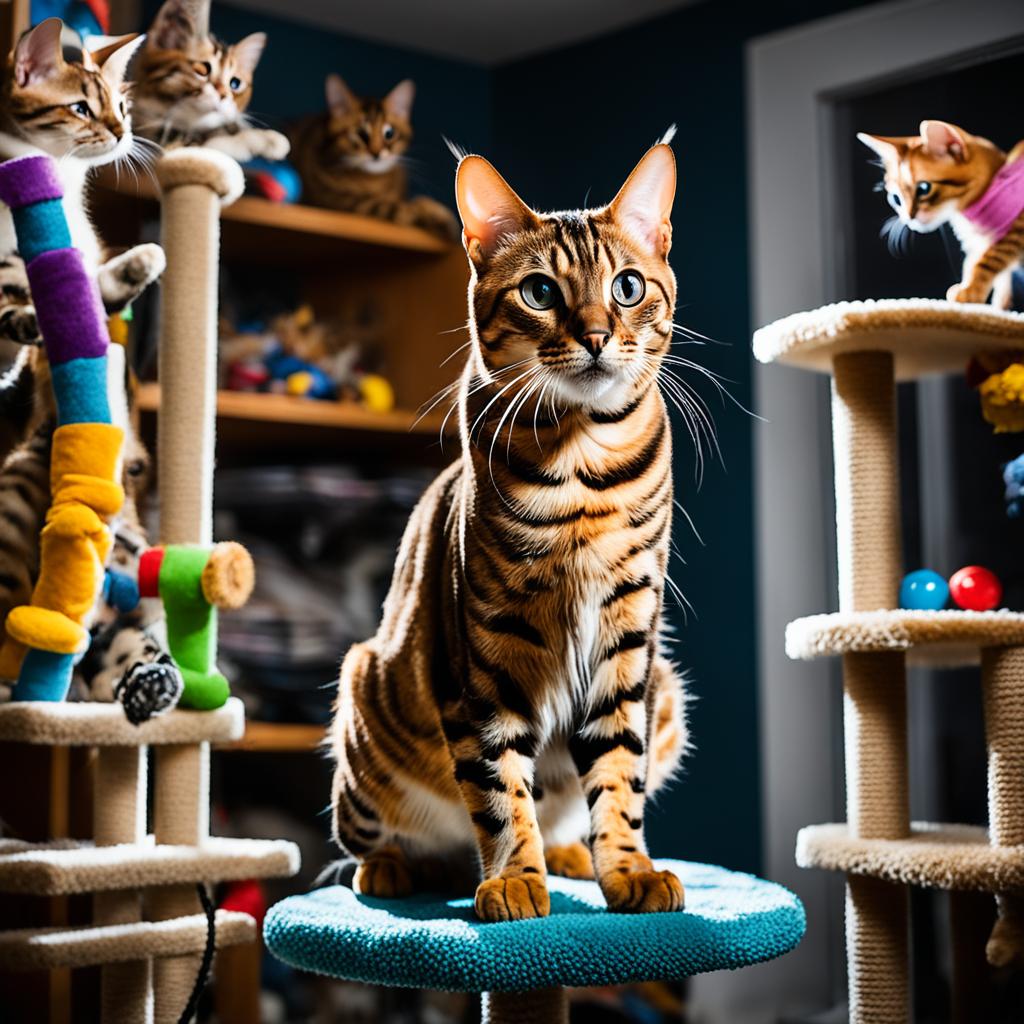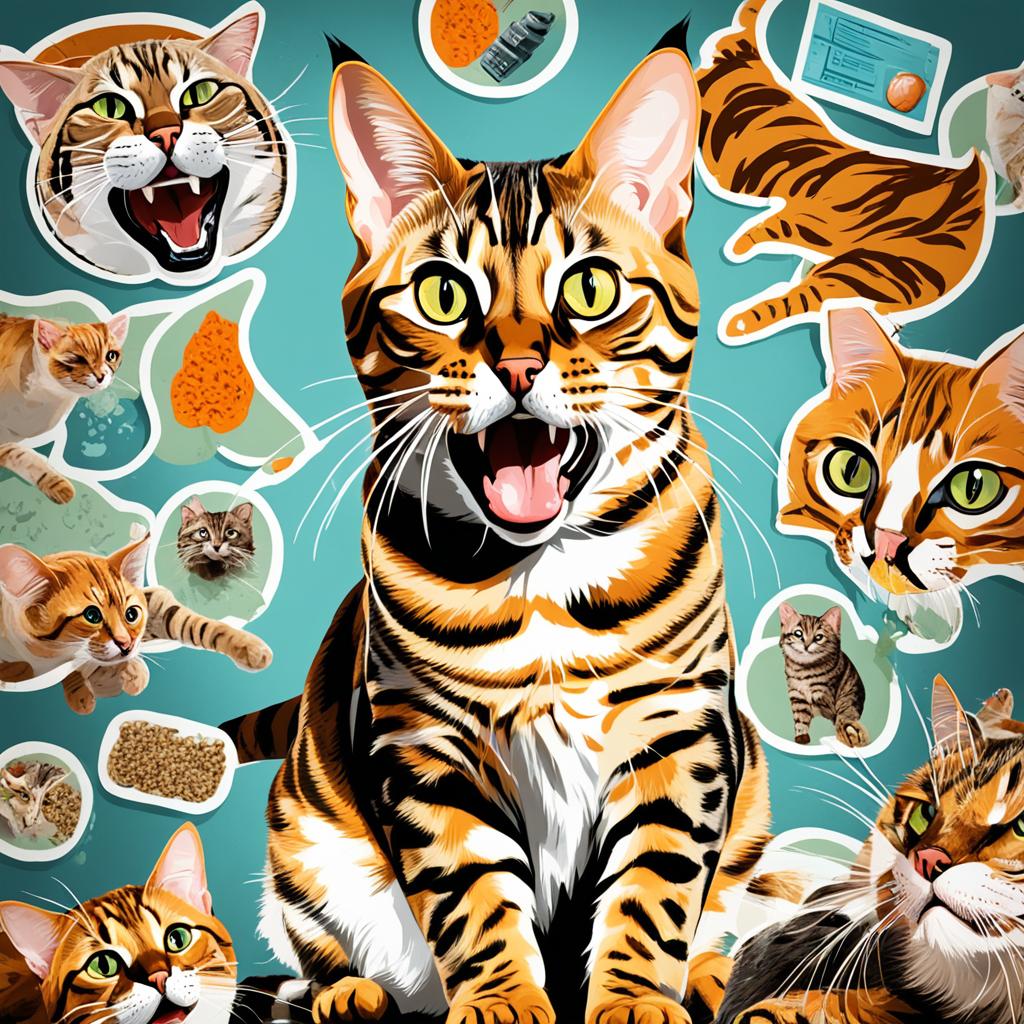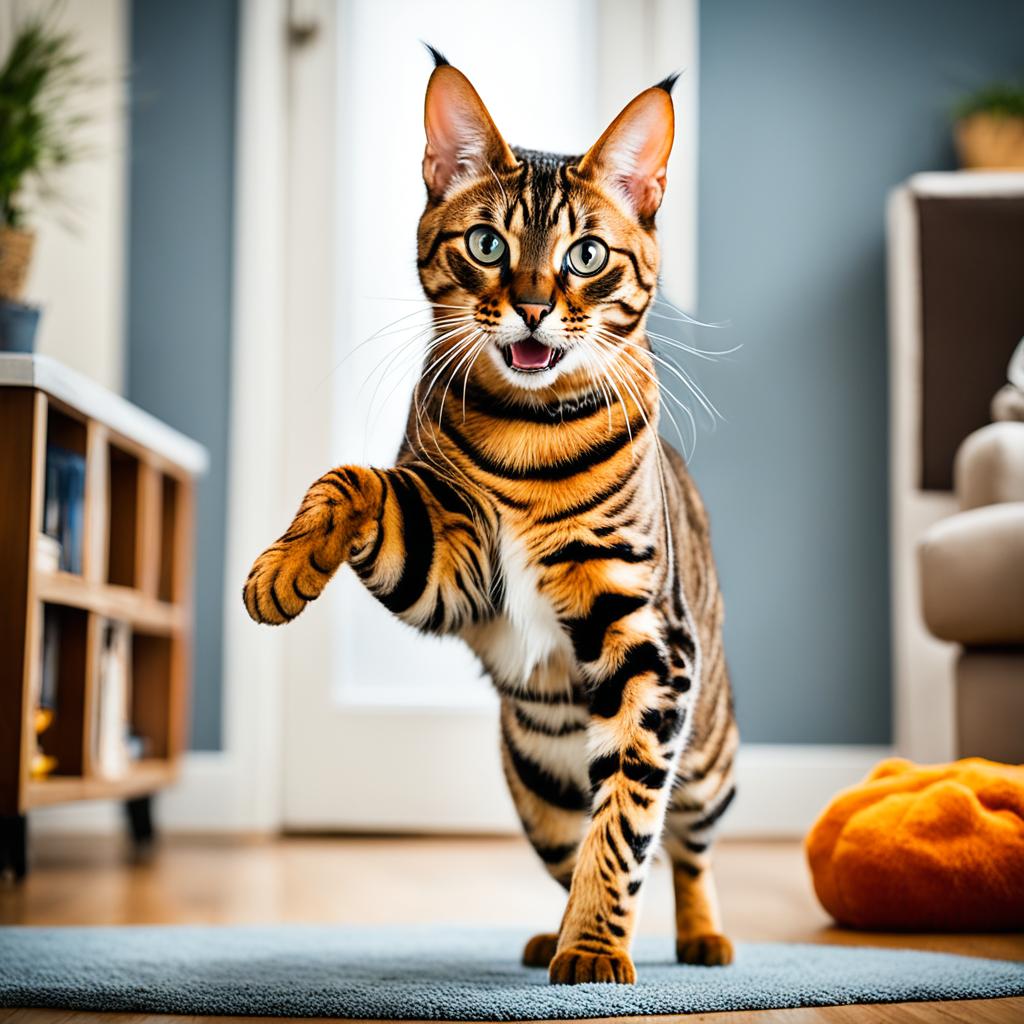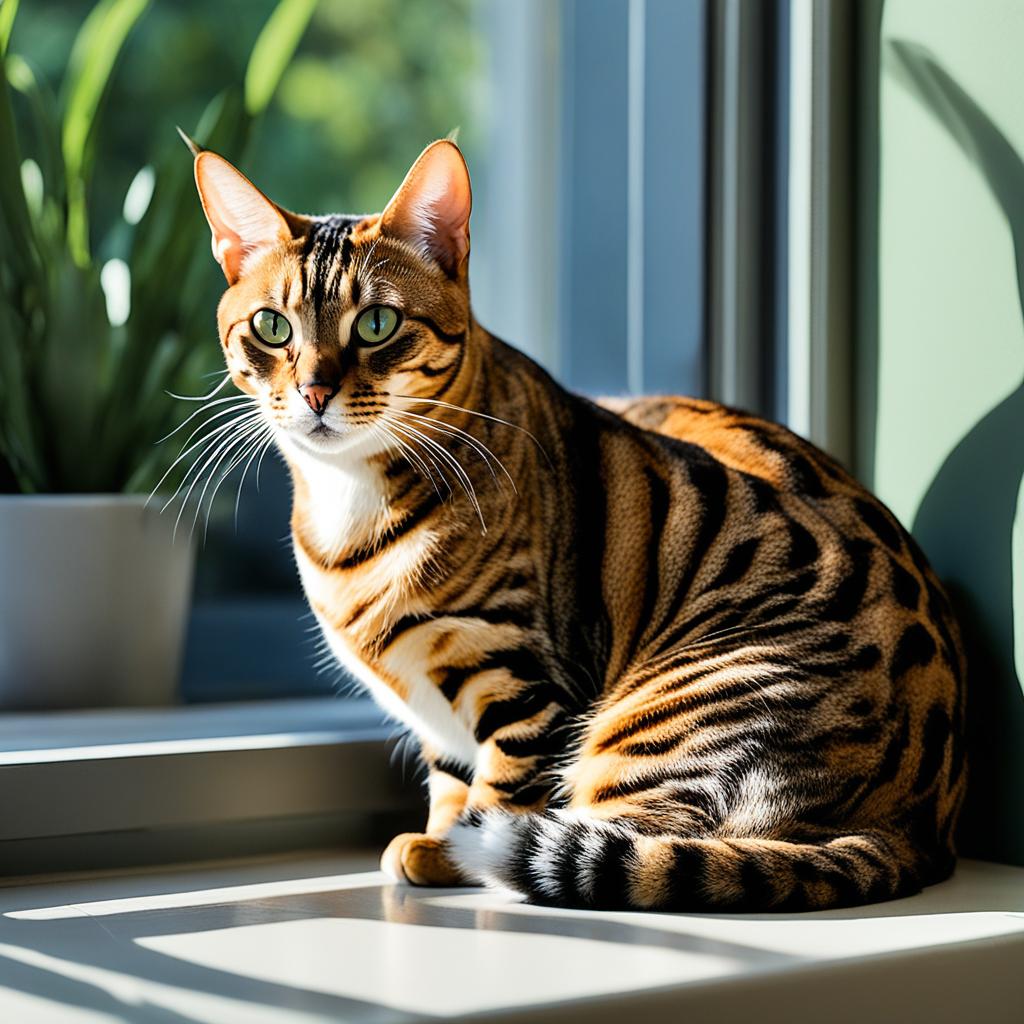Can a Bengal cat’s playful demeanor turn into unprovoked aggression? Bengal cats stand out with their mix of domestic traits and wild lineage from Asian leopard cats. They often win over pet owners with their looks and lively spirits. However, these beautiful cats can sometimes act out aggressively. This is usually when they’re bored or lack enough to keep them mentally and physically occupied. To keep your Bengal cat from becoming aggressive, it’s vital to know about the different types of aggression, what causes them, and how to address and prevent these behaviors.
Key Takeaways
- Understand the types of aggression in Bengal cats.
- Recognize boredom and understimulation as common causes.
- Implement positive reinforcement training techniques.
- Ensure your Bengal cat’s environment is engaging and stimulating.
- Consult professionals if severe aggression persists.
Understanding Bengal Cat Behavior Problems

Bengal cats have unique behavior issues just like their unique looks. They’re usually full of energy and love to play. But, at times, playfulness turns into too much aggression.
To deal with a Bengal cat’s aggressive behavior, it’s vital to know the cause. Start by looking at the different kinds of aggressive actions they might show.
Common Aggressive Behaviors
Aggression in Bengal cats varies:
- Territorial disputes
- Fear-induced reactions
- Redirected frustration
- Playful roughhousing
- Petting-induced aggression
Every kind of aggression needs a different approach. We’ll explore why these issues come up in Bengal cats.
Why These Issues Arise
Ever wonder why your friendly Bengal acts out? There are several reasons:
- Environmental Shifts: New places or even rearranged rooms can stress them out.
- Health Issues: Hidden health problems can make them lash out.
- Genetic Predispositions: Some behaviors might be in their genes.
- Need for Stimulation: Bengals need lots of play and mental exercise.
- Dietary Contributions: What they eat can affect their behavior too.
By knowing these reasons, you can use the right techniques for calming aggressive Bengal cats. This creates a happier home for both you and your cat.
The Importance of Socialization in Bengal Cats

Socializing Bengal cats is key to reducing their territorial behavior. It involves starting their training early with the right introduction methods. This helps them adjust well to different places.
How to Introduce Bengals to New Environments
First, let your Bengal explore new spaces slowly. Start with one room and then gradually open up more areas. This method lowers stress and decreases aggression.
Socializing with Other Pets
Introducing Bengals to other pets should be slow and thoughtful. Make sure pets have similar activity levels when bringing them together. Doing this in a careful way helps prevent fights and promotes fun times for all pets.
Teaching Bengal cats to be less aggressive takes time and a well-thought-out plan. But when done right, it makes your Bengal a joyful part of the family.
How to Handle Aggression in Bengal Cats?
Dealing with how to handle aggression in Bengal cats changes life for both you and your cat. The key is understanding why your Bengal acts out. It could be from boredom, fear, or not enough socializing.
Encouraging good behavior is the best approach to calm aggression. Use treats or affection to reward them. Avoid negative actions like water spraying or hitting. These can make the problem worse and hurt your relationship.
Set up an environment that’s good for your Bengal, like plenty of places to climb and toys. This reduces their stress and helps them use their energy in a positive way.
If things don’t improve, getting help from a professional is a good idea. An animal behaviorist or a vet can find out if there’s a health issue or provide tailored advice.
Environmental Factors Contributing to Aggression

Dealing with a Bengal cat’s behavior takes more than just playthings and snacks. Environmental influences play a big role in how your cat acts. This can cause issues like aggression. Knowing these impacts is crucial to create a peaceful home.
Changes in the Home Environment
Changing homes or rearranging the furniture can stress Bengal cats out. They are very sensitive to changes. Stuff like moving or adding new pets can make them feel defensive or territorial.
It’s key to help them through these times. Provide a quiet, safe spot. This can allow them to adjust without getting overwhelmed.
The Impact of Boredom and Understimulation
Bengal cats are smart and full of energy. They need lots of things to keep them busy. If they get bored, they might act aggressively. So, it’s important to have plenty of fun stuff around for them.
If your Bengal cat has enough things to do, they won’t get as stressed. Having a routine with fun activities will help them be calm and happy. This prevents behavior problems like being too territorial or scared.
Health Issues that Can Cause Aggression in Bengal Cats

Surprised by your Bengal cat’s sudden aggression? It could be a health problem showing up. Let’s look at how common medical issues might be behind the aggression. And how you can deal with it.
Common Medical Conditions
Bengal cats can face a variety of health concerns. These include neurological diseases, arthritis, and dental issues. Such problems might lead to serious pain, causing unexpected aggressive behavior. Always check with your vet to manage or treat these conditions.
The Role of Nutrition
Feed Bengal cats well to help avoid health problems and aggressive behavior. Choosing high-quality cat food is key. It helps your cat get the nutrients they need. This way, you can support their health, keep them calm, and their claws tucked away.
Effective Training Techniques for Aggressive Bengal Cats

Training aggressive Bengal cats the right way is crucial. It can make your home peaceful or full of trouble. It’s all about using gentle methods to encourage the good and correct the bad behavior.
Positive Reinforcement Strategies
Positive reinforcement is key in Bengal cat training. Reward your cat with treats, praise, or play when they act well. This teaches them to keep acting that way without fearing you. Remember, being consistent is important for this to work.
- Treat Rewards: Give your cat a small treat right away for good behavior. This shows them that acting good leads to good things.
- Verbal Praise: Saying nice things in an excited voice can make a Bengal cat feel happy and loved. This encourages them to behave.
- Interactive Play: Playing together helps your cat burn off energy. It also strengthens your bond and encourages good behavior.
With Bengal cats, you need lots of patience and never give up. Even accidentally rewarding bad behavior can increase their aggression. Knowing your Bengal’s style helps in choosing the best training methods.
Building trust and using positive methods are essential. This way, managing a Bengal cat’s aggression becomes easier. Your cat can stay a cherished part of your family.
Creating a Stimulating Environment for Bengal Cats

Creating a fun space for your Bengal cat helps reduce their aggression. These cats are full of life and need mental challenges. So, the right toys and areas are essential for them.
Interactive Toys and Games
Engaging Bengal cats with interactive toys is a key tip. Toys like laser pointers, feather toys, and motion-activated gadgets are perfect. They keep Bengals busy and entertained for a long time.
Puzzle feeders are also great. They help cats think and play at the same time, making aggression less likely.
The Benefits of Safe Outdoor Spaces
Letting Bengal cats out in safe places helps with their aggression. An outdoor enclosure or a “catio” is great for exploring safely. Leash walks provide exercise and echo their natural hunting behaviors.
Having trees and perches indoors lets Bengals burn off energy. It also mimics their wild climbing habits.
| Enrichment Options | Benefits |
|---|---|
| Puzzle Feeders | Stimulate mental activity and curb feeding aggression |
| Laser Pointers | Provide vigorous exercise and mental stimulation |
| Climbing Trees | Emulate natural climbing needs and offer physical exercise |
| Safe Outdoor Spaces | Encourage exploration and reduce stress |
By adding these to your Bengal cat’s life, you make your home a better place. It helps with aggression and strengthens your bond. You’ll see a happier cat and enjoy a closer connection with them.
The Benefits of Neutering for Reducing Aggression

Neutering is key in dealing with aggression in Bengal cats towards people. This common surgery can change the game by lessening their aggressive actions. Even if you enjoy their lively nature, neutering can make them more loving and peaceful.
- Hormonal Balance: Neutering is effective in balancing hormones. This cuts down on their urge to fight over territory and be confrontational.
- Reduced Spraying: Neutering often stops cats from marking their territory by spraying indoors.
- Lesser Restlessness: Without the urge to mate, a neutered Bengal cat is more easy-going.
Speaking with your vet before neutering is wise. They can help decide the best time for your cat. This decision is crucial in making sure your Bengal cat is less aggressive towards you. It leads to a better life together.
| Benefit | Description |
|---|---|
| Hormonal Balance | Stabilizes hormones, reducing territorial behaviors |
| Reduced Spraying | Decreases the tendency to mark indoor territory |
| Lesser Restlessness | Diminishes mating instincts, promoting relaxation |
When to Seek Professional Help for Your Bengal Cat
Sometimes, your Bengal cat’s aggression might get too tough to deal with alone. Knowing when it’s time to get expert help is crucial. This help can improve your cat’s well-being and bring calm back to your home. Figuring out who to turn to for help and what they can do is also important.
Consulting a Veterinarian
If your Bengal cat starts being very aggressive all of a sudden, a vet should be your first stop. They will check for any health issues that could be behind the behavior. Things like pain, brain problems, or hormone changes can make a cat act out. A vet visit will help find and fix these issues, giving your Bengal cat the medical attention it needs. Professional advice from a vet is a big help when aggression won’t let up.
Behavioral Specialists
After making sure it’s not a health problem, a behavior expert could be the next move. These specialists know a lot about how cats think and can come up with plans to stop aggression. They’ll give you advice on training, making your cat’s space better, and letting your cat meet others if needed. Getting help from these experts can really change things at home.
Knowing when to get help for an aggressive Bengal cat is key. Working with both vets and behavior specialists gives you the best chance to make a peaceful home for everyone. When fighting aggression, don’t wait. Getting expert help is a smart choice for both your cat’s joy and your own peace.




